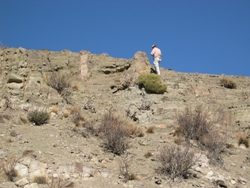
Much of the surface of Patagonia is covered with a layer of gravel (the Rodados Patagónicos in modern terminology), which Darwin first saw at Bahía Blanca and which he named the “Patagonian Shingle Formation”. Oscar Martínez et al. stress Darwin’s surprise at the vast extent of these deposits and note his conclusion that they initially accumulated as alluvial sediments at the foot of the Andean Cordillera, to be subsequently redeposited during a marine transgression. But the marine shells that Darwin recorded are now believed to represent man-made accumulations. The Rodados Patagónicos actually includes gravels of various ages and provenance, including piedmont deposits (in northern Patagonia) and glacifluvial deposits further south.
Darwin also recorded some large erratic blocks and associated gravels during a journey along the valley of the Río Santa Cruz (S. Patagonia). Jorge Strelin and Eduardo Malagnino stress the continuing validity of Darwin’s detailed observations on their stratigraphy and geomorphology. However, while Darwin interpreted these sediments as glaciomarine, they are now regarded as terrestrial, some marking the maximum glacial expansion in Argentina, others “linked to moraines and glacifluvial terraces of the Penultimate Glaciation”.
At the mouth of the Río Santa Cruz, Darwin recorded some marine sediments (now included in the Early Miocene Monte León Formation). Ana Parras and Miguel Griffin show that these were deposited in an inner shelf to subtidal or even intertidal environment. From here and from another locality further north at Puerto Deseado (Port Desire, described by Silvio Casadío and Miguel Griffin) Darwin collected fossils that were later described by G B Sowerby.